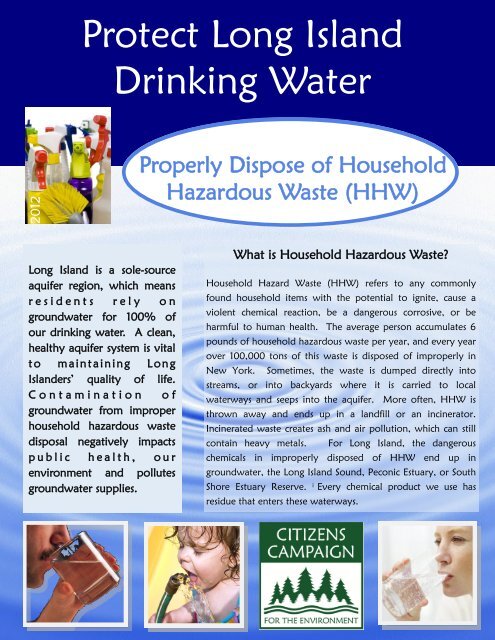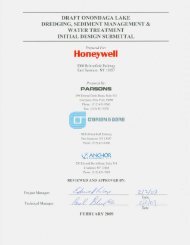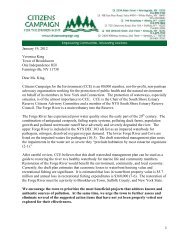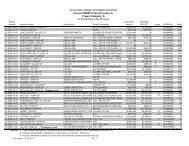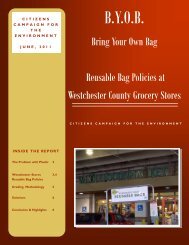Protect Long Island Drinking Water - Citizens Campaign for the ...
Protect Long Island Drinking Water - Citizens Campaign for the ...
Protect Long Island Drinking Water - Citizens Campaign for the ...
Create successful ePaper yourself
Turn your PDF publications into a flip-book with our unique Google optimized e-Paper software.
2012<strong>Protect</strong> <strong>Long</strong> <strong>Island</strong><strong>Drinking</strong> <strong>Water</strong>Properly Dispose of HouseholdHazardous Waste (HHW)<strong>Long</strong> <strong>Island</strong> is a sole-sourceaquifer region, which meansr e s i d e n t s r e l y o ngroundwater <strong>for</strong> 100% ofour drinking water. A clean,healthy aquifer system is vitalt o m ain t aining L ong<strong>Island</strong>ers’ quality of life.C o n t a m i n a t i o n o fgroundwater from improperhousehold hazardous wastedisposal negatively impactsp u b l i c h e a l t h , o u renvironment and pollutesgroundwater supplies.What is Household Hazardous Waste?Household Hazard Waste (HHW) refers to any commonlyfound household items with <strong>the</strong> potential to ignite, cause aviolent chemical reaction, be a dangerous corrosive, or beharmful to human health. The average person accumulates 6pounds of household hazardous waste per year, and every yearover 100,000 tons of this waste is disposed of improperly inNew York. Sometimes, <strong>the</strong> waste is dumped directly intostreams, or into backyards where it is carried to localwaterways and seeps into <strong>the</strong> aquifer. More often, HHW isthrown away and ends up in a landfill or an incinerator.Incinerated waste creates ash and air pollution, which can stillcontain heavy metals. For <strong>Long</strong> <strong>Island</strong>, <strong>the</strong> dangerouschemicals in improperly disposed of HHW end up ingroundwater, <strong>the</strong> <strong>Long</strong> <strong>Island</strong> Sound, Peconic Estuary, or SouthShore Estuary Reserve. i Every chemical product we use hasresidue that enters <strong>the</strong>se waterways.
The Most Common Examples of HHW:Study of VOCs in Nassau anAerosol ContainersAntifreeze and Brake FluidsAutomotive BatteriesElectronics and Household BatteriesHousehold Cleaners and Personal ProductsMedicinesMercuryMotor Oil and Automobile ProductsPaint Thinners, Strippers and o<strong>the</strong>r SolventsWood PreservativesPesticidesVOLATILE ORGANIC COMPOUNDS FROM HHWARE CONTAMINATING LONG ISLAND GROUNDWATERVolatile Organic Compounds (VOCs), a source of which are HHW, are being found withincreased frequency in <strong>Long</strong> <strong>Island</strong>’s aquifers. VOCs used in <strong>the</strong> most common products ofHHW were found at high concentration in <strong>the</strong> Magothy Aquifer, which is Nassau County’smain source of drinking water. These findings prompted <strong>the</strong> Environmental <strong>Protect</strong>ion Agency(EPA) to add areas of Hicksville, New Cassel, Westbury, Hempstead and Salisbury to <strong>the</strong> list ofSuperfund National Priorities in September, 2011. iiThe three most common VOCs, Tetrachloroe<strong>the</strong>ne (PCE), Trichloroe<strong>the</strong>ne (TCE), and 1,1,1-Trichloroethane (TCA), which are found in a range of products including paint strippers, officesupplies, aerosols and cleaning products, were detected in Suffolk County groundwater athigher levels in 2005 than in 1987. In fact, VOC levels were 4 times higher in 2005, with PCEhaving increased over 100% and TCE increasing 150% in 18 years. Many of <strong>the</strong> wells testedthroughout <strong>Long</strong> <strong>Island</strong> had elevated levels of VOC contamination.Increased levels of VOC contamination along with substantive increases in nitrates andpesticides have created drinking water contamination problems. Inadequate infrastructureexists to deal with or treat <strong>the</strong> bi-products of HHW. The combination of increased demand<strong>for</strong> water as <strong>Long</strong> <strong>Island</strong>’s population grows and increased contaminants from HHW have ledto a “continuous and gradual decline” in water quality identified in <strong>the</strong> Suffolk CountyComprehensive Resources Management Plan. iii
d Suffolk Wells ivVOC’s DetectedIMPACTS ON HUMAN HEALTHHHW products are toxic and corrosive, and can be carcinogenicand contain heavy metals. They can cause both acute and chronichuman health problems, including skin burns/rashes, cancer, birthdefects, kidney and liver damage, nervous system disorders, andrespiratory problems when absorbed through <strong>the</strong> skin or ingested.When <strong>the</strong>se chemicals enter <strong>the</strong> drinking water supply, <strong>the</strong>yaccumulate and residents are exposed to low levels of harmfulcontaminants every day. Some common examples include: vMethylene Chloride – Found in paint removers, pesticides anddegreasers; it is a possible carcinogen which aggravates heartconditions and may cause heart attacks.Methanol – Found in antifreeze, paint and windshield wiperfluid; it is highly toxic and direct exposure can cause blindnessand death.Cadmium – Found in batteries and paint, this heavy metalbioaccumulates and causes kidney and bone damage.Benzene – Found in paint removers, varnishes and gasoline; itis a type of petroleum that is carcinogenic and quicklyabsorbed by <strong>the</strong> blood, poisoning bone marrow and causingcentral nervous system disorders.USING LESS HAZARDOUS PRODUCTSThe easiest way to reduce individual HHW is to have individuals use less hazardous products.Promoting less toxic products coupled with educating <strong>the</strong> consumer on <strong>the</strong> proper use anddisposal of a hazardous product at <strong>the</strong> time of purchase would mitigate many of <strong>the</strong> problemsassociated with HHW contamination. Many states, including Washington, Oregon andVermont, have implemented programs where <strong>the</strong> public is notified if a product <strong>the</strong>y arepurchasing is hazardous, less hazardous alternatives are promoted, and <strong>the</strong> most harmfulproducts are carefully regulated or removed from shelves entirely. Suffolk County passed a lawnearly 20 years ago requiring stores to post signs notifying customers of hazardous products andproper disposal methods, yet <strong>the</strong> law has never been implemented. Notifying <strong>the</strong> public andgiving <strong>the</strong>m option to make smart, safe choices <strong>for</strong> <strong>the</strong>mselves and <strong>the</strong>ir communities is essentialto diminishing <strong>the</strong> amount of toxic waste that get dumped into <strong>Long</strong> <strong>Island</strong>’s soil andwaterways. Many harmful products, from pesticides to MTBE to mercury, were once commonin HHW and are now regulated and removed from everyday products and retail stores. Saferalternatives <strong>for</strong> many of <strong>the</strong> most common HHW products exist, and consumers should begiven every opportunity to be proactive about <strong>the</strong>ir choices.
STOP THROWING OUT POLLUTANTS (STOP) DAYSOne thing municipalities and townships throughout <strong>Long</strong> <strong>Island</strong> are doing to alleviate <strong>the</strong> problem isholding STOP days, at which residents can bring in <strong>the</strong>ir hazardous waste <strong>for</strong> proper disposal. Thesehave been widely publicized, often on municipalities’ websites, and are a method of educating <strong>the</strong>public on what constitutes hazardous waste, <strong>the</strong> public health risks <strong>the</strong>y pose, and why properdisposal is necessary.All <strong>Long</strong> <strong>Island</strong> towns host resident STOP days. Some towns, such as Huntington and Brookhaven,have a permanent drop-off point where residents are able to bring products. O<strong>the</strong>r towns, such asSmithtown and Babylon, designate several days a year were residents can bring HHW to <strong>the</strong> town<strong>for</strong> safe disposal. The Town of Oyster Bay, <strong>for</strong> example, has collected approximately 14,000 55gallon drums of hazardous waste from over 96,000 households since <strong>the</strong>ir STOP program began. viWhile <strong>the</strong>se programs are a good start, <strong>the</strong>re needs to be a more coordinated ef<strong>for</strong>t on <strong>the</strong> part of<strong>the</strong> townships and New York State to provide a uni<strong>for</strong>m policy <strong>for</strong> HHW disposal. Eachmunicipality has a different method of collecting hazardous waste, and some are better publicizedand better attended than o<strong>the</strong>rs. These STOP programs have generated meaningful publicparticipation, but <strong>the</strong>y need to be more consistent and more widely publicized in order ensure largescaleresident participation.For more in<strong>for</strong>mation on HHW programs in your area contact your local officials or visit:http://www.dec.ny.gov/chemical/8485.htmli. New York State Department of Environmental Conservation Division of MaterialsManagement. Managing and Disposing of Household Hazardous Waste. http://www.dec.ny.gov/docs/materials_minerals_pdf/hhwma.pdfii. United States Department of Environmental Conservation. EPA Adds Areas of <strong>Long</strong><strong>Island</strong> to <strong>the</strong> Superfund List; Volatile Organic Compounds found in 11 Major <strong>Drinking</strong><strong>Water</strong> Wells. 15 Septemer, 2011. http://yosemite.epa.gov/opa/admpress.nsf/0/E03A1C90BE899D158525790C0062B769.iii. Amper, Espostio, McDonald, Gobler, C., McAllister, &DeLuca. <strong>Water</strong> Worries:Suffolk Report Documents Decline Without Prescription <strong>for</strong> Remedy. http://www.pinebarrens.org/pdfs/FINAL<strong>Water</strong>Worries6.11.pdfiv. Eckhart, D. & Stackelberg, P. Relation of Ground-<strong>Water</strong> Quality to Land Use on<strong>Long</strong> <strong>Island</strong>, New York. 1995. http://info.ngwa.org/gwol/pdf/952964078.PDFv. Bowen, C. Household Hazardous Products and Hazardous Waste: A Summary <strong>for</strong>Consumers. University of Pennsylvania. 1998. http://pubs.cas.psu.edu/FreePubs/PDFs/xi0014.pdfvi. Town of Oyster Bay Department of Environmental Resources. 2000 S.T.O.P andElectronic Waste Recycling Program. http://www.oysterbaytown.com/vertical/Sites/%7B7D6BDBFB-65E8-4A80-B369-DE0267DC78CB%7D/uploads/%7BA1018F0F-3C61-4E24-9100-B1438A4C41E0%7D.PDF.<strong>Long</strong> <strong>Island</strong>/Metro New York225-A Main StreetFarmingdale, NY 11735Phone: 516-390-7150Hudson Valley188 East Post Road, Suite #404White Plains, NY 10601Phone: 914-358-9840Capital Region/North Country744 BroadwayAlbany, NY 12207Phone: 518-772-1862Central New York/Finger Lakes466 Westcott Street, 2nd FloorSyracuse, NY 13210Phone: 315-472-1339www.citizenscampaign.orgCCE would like to thankThe Moore Charitable Foundation <strong>for</strong> <strong>the</strong>irgenerous support.Funding provided by <strong>the</strong> NYS PollutionPrevention Institute through a grant from <strong>the</strong>NYS Department of Environmental Conservation.Any opinions, findings, conclusions orrecommendations expressed are those of <strong>the</strong>author(s) and do not necessarily reflect <strong>the</strong> viewsof <strong>the</strong> Department of EnvironmentalConservation.Western New York/Sou<strong>the</strong>rn Tier733 Delaware Road, Box 140Buffalo, NY 14223Phone: 716-831-3206Connecticut2404 Whitney Avenue, 2nd FloorHamden, CT 06518Phone: 203-821-7050


